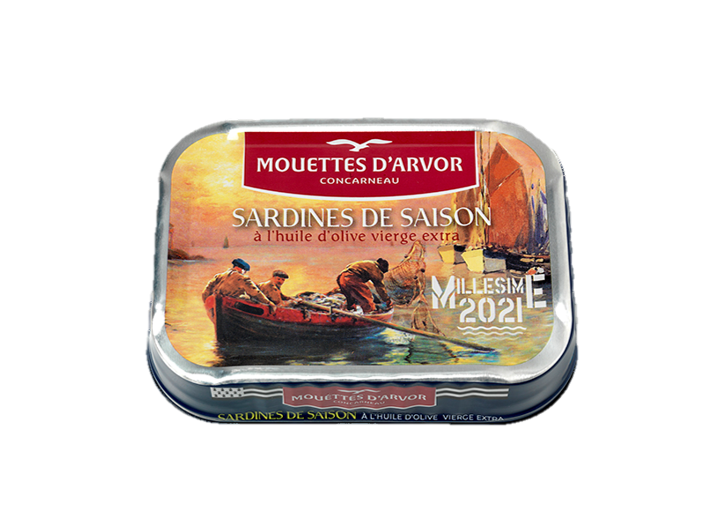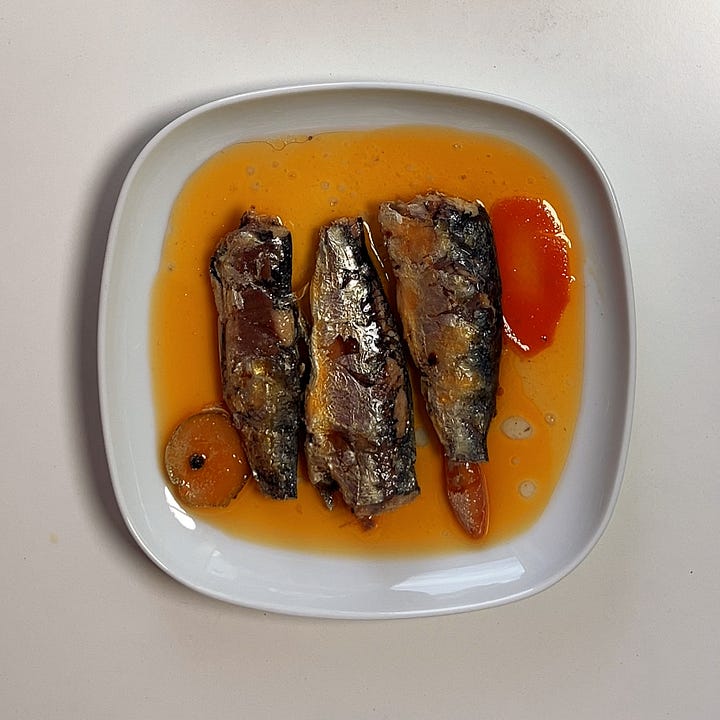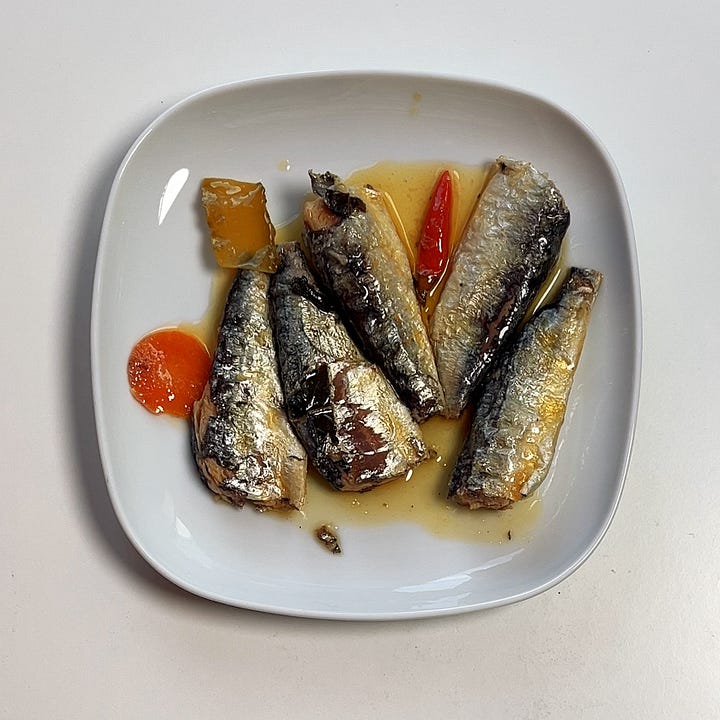Does aging canned sardines make a difference?
How old can sardines go? And how to age your own tinned fish
It’s no secret I enjoy eating canned seafood, trying new species, sauces, preparations, and producers. Tinned fish is ubiquitous, yet I’m continually reminded just how little I know about it—the niches within the niche. I often compare tinned fish to wine: it’s a staple in many cultures, influenced by terroir, varies wildly in price, and changes with age.
While I was living in Baltimore a few years back, I took a pilgrimage (a few hours’ drive) to Rainbow Tomatoes Garden’s former location in East Greenville, Pennsylvania to shop in person. For context, Rainbow Tomatoes Garden carries the largest variety of tinned fish online. Their customer service is top notch— they’re true experts I often look to as I’m researching about tins. It was here I met Dan, and I first heard about aged sardines.
What are aged sardines?
Simply put, aged sardines are sardines that have been left in the can for a period of time after packing. In my conversation with Dan, he took the time to explain the difference between aged sardine tins and collectible sardine tins. Both have dates printed on the front, but one is packed on the listed date and the other is the same as the regular product from that year. If you see the Fantastic World of Portuguese Sardine (produced by Comur), I hate to break it to you—that $15 tin of sardines printed with “2014” was most certainly NOT harvested or packed in the corresponding year.


I’ve briefly mentioned aging canned fish in previous social media videos ($1 vs. $25 sardines), and I posted a new video yesterday (link to video) comparing Nuri’s 2020 reserva limited edition tin to its regular spiced sardines in olive oil. While the ingredient labels are identical, the two tins are treated differently.
Why age sardines?
When I visited the Pinhais facility in Matosinhos, Portugal last fall I made sure to ask about their Reserva limited edition sardines. Does aging sardines make a difference? Nuri responded:
“The aging of our Seasoned Sardines in Olive Oil brings out their flavors (umami), making the fish more tender and soft and a very special product for us to enjoy!’
At Pinhais they include aging as part of their process for all sardine products. Even the regular tin of spiced sardines I purchased in 2024 is required to be aged for 3 months before sale. The logic is for the spices and fish to infuse into the oil, for the flavors to mingle and mature.
Nuri isn’t the only producer that offers vintage sardines, Gonidec, Rödel, Pollastrini, Connétable and several other producers all have similar vintage lines preserving the best catch of the year.
As I’ve tried many tins of aged sardines—some aged by the producer, others unintentionally left in my pantry—the main differences I notice in tinned fish aged 1 year or more is softer texture and mellower flavor.
The softer texture is easily explained as fish proteins and bones break down in the oil. As fish and oil become one with time, it leaves a richer mouthfeel without being greasy. When searching for anecdotes on the flavor of aged fish, I found out Harold McGee (author of one of my favorite food science books On Food and Cooking) wrote an article in a 2014 fall issue of now-defunct Lucky Peach quarterly food journal.
In the article titled “On Cans”, he mentions how aging canned fish may temper unpleasant aromas:
…whatever happens in the can stays in the can—no aromas can escape. Hence the common presence of a sulfurous quality, which may be eggy or meaty or oniony or cabbagy or skunky, from compounds like hydrogen sulfide, various methyl sulfides, and methanethiol. Some of these notes can gradually fade during storage as the volatiles slowly react with other components of the food.
When I think about an audience for aged sardines, I think of the most niche of the niche, the tinned fish enthusiast. With McGee’s hypothesis, perhaps vintage tins could be an excellent choice for those new to tinned fish, as they address common objections like strong aromas and crunchy bones.
That said, there’s also the question of is the difference noticeable enough and is it worth it?


A tinned fish triangle taste test
With my two tins of Nuri sardines, the texture change was evident: the newer sardines showed firm flakes under the pressure of my fork, while the 5-year-old Reserva sardines fell apart at the lightest touch.
I also set up a blindfolded triangle taste test, where I tried three samples: 2 of one vintage and 1 of another. The goal of a triangle test is to see if a participant can identify “the odd one out”. This test is often used when companies reformulate a product or to compare similar competitor products.
In my triangle test I failed to correctly identify one of the samples. I’m not the foremost expert in eating canned sardines, but I will confess I’ve had over 100 tins of Nuri spiced sardines in olive oil alone. Back to the wine analogy, taste and product knowledge is acquired, not innate. The more data points you have the more likely you can tell the difference, especially if you know what to look for. While aged sardines are generally agreed upon to be “better” than unaged ones, it requires a refined palette and knowledge of the product to pinpoint the nuances (which I don’t possess, yet).
In truth, I think vintage sardines rely more on being a fun nostalgia-driven marketing concept than a significantly different eating experience.
Are vintage sardines worth it?
It’s important to note that the cost between the two vintages I tasted was quite drastic. Nuri’s normal spiced sardines are just €4.5 while the Nuri Reserva 2020 comes in at €14, 111% more. Considering the sample size is just me, and I don’t claim to have a refined palate, is it worth it to buy aged sardines?
It’s important to know you’re getting a premium product even if you don’t factor in the age. Producers typically reserve their best, fattiest catch of the year for these vintage tins, selected from a window of just a week or two. You’re guaranteed to receive fresh fish, not frozen. Fishing yields are affected by climate and weather events, adding further confounds to the comparison. By collecting various vintages, we’re no longer just considering age, we’re also comparing the catch from year to year.
How long is too long?
There’s no scientific consensus on the “best” amount of the time to age a can of sardines, plus taste is fundamentally subjective. That said, anecdotal evidence from the community can provide general guidelines.
Are canned sardines safe to eat after so many years?
Tinned fish are put through an autoclave, cooked under high pressure to render them effectively sterile. This means it’s generally safe to consume beyond the “best by” date, though safe doesn’t equal tasty. I found a blog post by Mouth Full of Sardines from 2015 documenting a taste test of vintage 1968 Yugoslavian sardines. Which was described as follows:
The after taste was pure metal. My tongue felt as if it had suddenly grown fur. After three pints, the taste remained in my mouth.
How sardines change with time
When stumped with finding evidence to suggest an ideal timeline, I consulted Dan from Rainbow Tomatoes Garden. He liaises with both producers and customers, so he’ll have more data points than just about anyone else on this topic. Here’s what he’s gathered on vintage products:
Year 1 through Year 5
They get better for about five years, most dramatically the first year, but noticeably thereafter.
Year 5+
After five years the general consensus is that changes continue, but there begins to creep in personal taste distinctions regarding whether those changes are better or just different.
Year 10+
After about ten years, data gets scant. And now people start reporting negative features (mushy mostly).
Year 15+
After about 15 years the highest compliment I have see is: still edible!
How to age tinned fish at home
If you’re interested in aged canned fish, there’s no better way to explore your preferences than to DIY and try them over time.
Acquire your fish of choice packed in oil, ideally several tins to be consumed year after year. Ensure there’s no sign of dents, rust, or compromised seals.
Mark the date to track their age. Store the tins in a cool dark place.
Many folks advise flipping the tins every 6 months, but don’t have the original source to substantiate this.
Open one tin each year and write down your observations.
While properly sealed tinned fish is generally safe, always check for signs of spoilage, like bulging cans, leaks, or off smells. When in doubt, toss it out!









Fascinating write up. Maybe this could spur up a niche industry of aged sardines. I wonder if ambient temp for can storage will affect the aging process.
I don't even eat tinned fish, although I'm a fan of the packaging, but this was such an interesting read. I'm on my way to buy a can of sardines